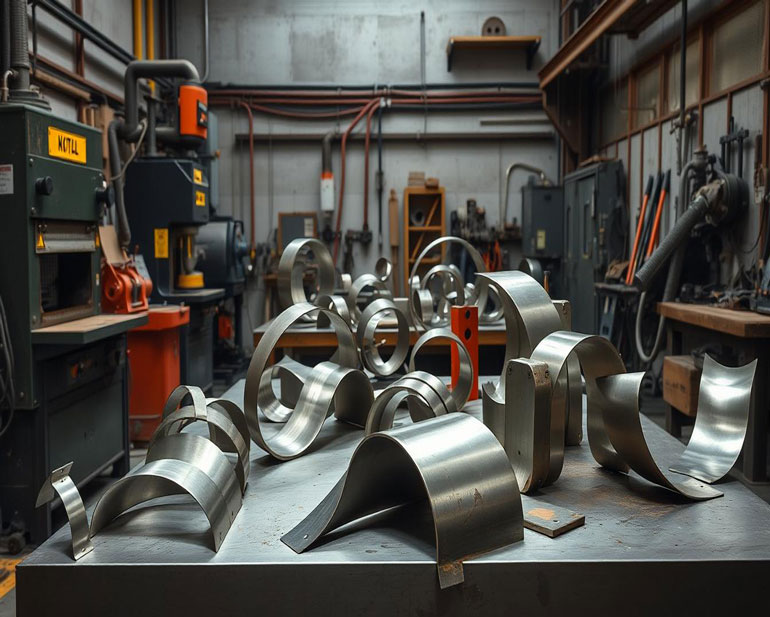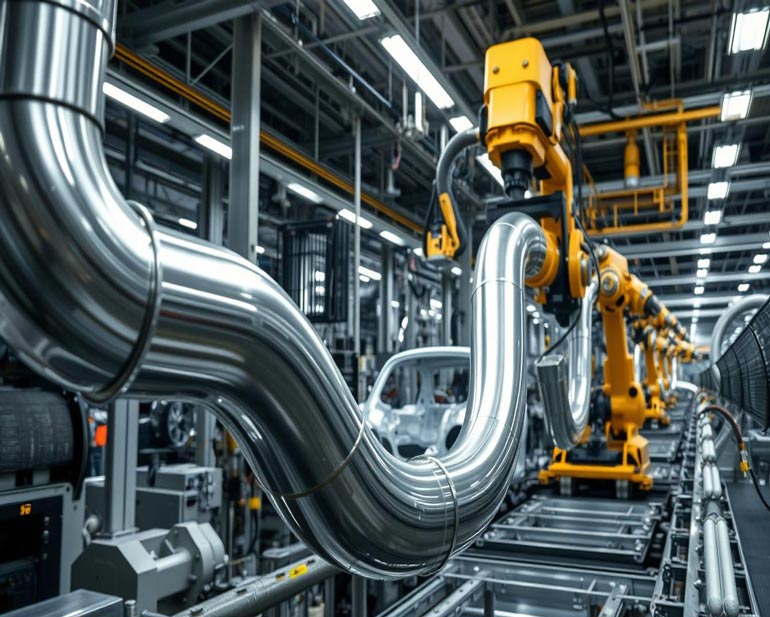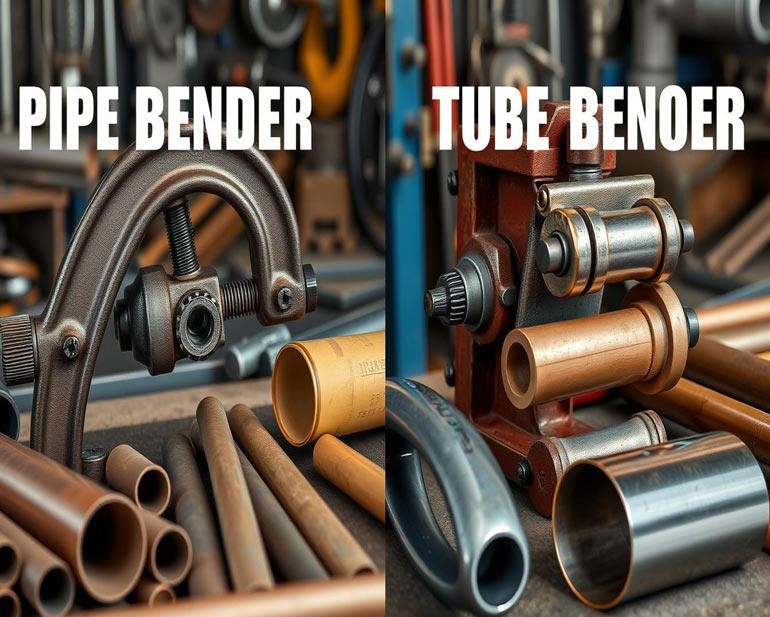Welcome to Mingzheng Precision Machinery
What are the Types of Bending Processes?

18 Mar
Discover the various bending processes, from sheet metal to CNC bending, and how they shape industry standards in metalworking and fabrication.
What are the Types of Bending Processes?
Metal bending is key to amazing structures and machines. Not all bends are the same. In this exploration, we will look at types of metal forming. We'll see how each method, from Air Bending to Coining, impacts making things. Have you thought about how bending techniques affect efficiency and lasting products? Or why some methods are better for strength and flexibility?
Air Bending is very common in sheet metal shops. It's well-liked for its flexibility and low cost of tools. It's important to know the differences. For example, 75-degree tooling improves upon Acute Angle Tooling. This upgrade boosts Air Bending's full abilities1. The choice of angles, like 30-degree or the special 90 or 88-degree, is key1. Air Bending lets you control the bend angle with punch travel. It also adjusts for spring-back with overbending. Meanwhile, Coining needs more force but gives very accurate pieces. It's often used in making things like electronics enclosures12.
Then there's Bottom Bending, known for its precision. It needs the die angle to match the workpiece’s angle exactly1. This method is for those who really know their stuff. It calls for expertise in tooling, materials, and timing1. Press Brake Bending is different. It's great for making various parts with the same tools. So, it's perfect for making small amounts2.
Choosing metal bending methods is a big deal. It's about more than just making a part. The decision affects efficiency, cost, and quality. Manufacturers use these methods to tackle challenges and shape our world. Let's explore the craft that defines today's manufacturing world together.

Understanding Metal Bending
In manufacturing, reshaping metals into useful parts is key. It shows how far technology has come. Metal bending methods are vital for creating many things we use every day. Let's learn more about these techniques and why they matter.
Foundations of Metal Forming
Metal forming changes sheet metal into complex shapes. It keeps the metal whole. CNC bending machines use computers for better accuracy and less waste. Sheet metal bending with CNC is reliable and meets high standards needed for making many items. Techniques like Air Bending and V-Bending change metals easily while keeping their quality and strength3.
Material Characteristics and Bend Allowance
The type of metal affects how it can be bent. This depends on its strength, how easy it is to shape, and if it resists rust. Aluminum is popular in planes for its light weight and ease of use4. Stainless steel doesn't rust, so it's perfect for kitchen tools and in factories3. The thickness of metal matters too. Sheet metal bending works with materials up to 20mm thick. This meets many needs with tools like hydraulic CNC press brakes, making exact bends easier54.
Significance in Various Industries
Metal bending is crucial in cars, planes, and building industries. Planes often use aluminum because it's light4. Cars need strong but flexible materials like brass and copper for parts that move or bend often3. Using metal bending methods such as CNC bending makes work faster. It lowers costs and makes products precise and consistent, which is very important5.
Explore further detailed talks on sheet metal bending and its big role in different fields.
| Metal Type | Common Uses | Key Properties |
| Aluminum | Aerospace, Automotive | Lightweight, Highly Malleable |
| Stainless Steel | Kitchen Appliances, Industry | Corrosion Resistance |
| Copper | Electrical Components | Excellent Conductivity3 |
| Brass | Fittings, Decorative Tools | Low Friction, Attractive Finish |
| Mild Steel | Construction | Great Formability, High Strength |
Insight into Bendable Metals and Alloys
We lead in metal bending, knowing the choice of metal is key. Aluminum, stainless steel, copper, and brass are picked for their special traits. These metals' ability to bend decides their use in fields like aerospace and building.
Aluminum, Stainless Steel, and Copper
Aluminum shines in making lightweight, rust-free parts for cars and planes6. Stainless steel is great for its rust fight and shaping, used in kitchens and factories6. Copper is top pick for its power to conduct electricity in gadgets6.
Mild Steel and Brass in Construction
In building, mild steel is known for being easy to shape but strong, used in structures and frames7. Brass is chosen for its smooth movement and looks, perfect for fancy parts and pieces7.
Material Thickness and Formability
The thickness of a material is crucial as it guides the bending. Thicker metals need more force and care to bend right7. Tech like CNC presses help handle thick metals well, ensuring bends match the needed shapes and uses.

Comprehensive Look at Bending Techniques
In the world of shaping metal, knowing different bending techniques is key. Press brake bending is vital in this field. It helps us understand what each method brings to metal shaping.
Tube bending processes, such as press and rotary draw bending, are very important. They are used in many industries. Press bending is simple and works well8. But rotary draw bending is best where you need high precision and want to avoid squishing the tube8.
There are more ways to bend tubes, like roll and mandrel bending. Roll bending uses three rollers to make big curves in metal, perfect for big structures8. Mandrel bending helps keep tubes from flattening when bending tightly8.
For complex shapes, press brake bending is your go-to. It enables detailed and accurate designs. With V bending and coining, you can shape metal sheets very precisely9. Coining makes sharp angles with little to no bending back, very useful for precise work9.
Each bending method changes the tools you need and what you can make. For example, V bending is great for exact angles in press brake bending. This helps make specific parts correctly9.
| Technique | Common Uses | Benefits |
| Press Bending | Plumbing, automotive frames | Simple, cost-effective |
| Rotary Draw Bending | Aerospace, architectural structures | High precision, smooth finish8 |
| Roll Bending | Large installation artwork, construction frameworks | Ideal for large-radius bends8 |
| V Bending | Sheet metal fabrication, brackets | Accuracy in bend angle, adaptable to different metals9 |
| Coining | Electronic components, high-precision parts | Minimal springback, high repeatability9 |
Knowing the details of each bending method helps us make our projects better. We make sure our work is efficient and high quality. From air bending's flexible angles to the exact results from coining and rotary draw bending, the field of tube bending processes keeps growing. This is thanks to new technology and the needs of different industries.
Essential Tools for Effective Metal Bending
In the world of making things, bending metal right is very important. The best tools for bending improve product quality and speed up work.
Press Brakes and Their Variations
Press brakes are key for bending metal. They use a punch and die. Old mechanical brakes are now mostly hydraulic. Hydraulic brakes work better for different metal types and thicknesses. They're good for bending thick metal plates accurately10.
CNC technology in these machines means less mistakes and better control. This is perfect for making a lot of things where every detail matters10.
The Role of Bending Dies and Rolling Machines
Bending dies help press brakes bend metal just right. The die's design and material matter a lot for the bending results10. Rolling machines are used for big-radius bends. They have three rolls that shape the metal11. These machines are important for making smooth curves in big projects and custom furniture.
Tube Benders: Manual vs Hydraulic
Tube benders can be manual or hydraulic, depending on the job. Manual ones need more effort but are great for small, precise work11. Hydraulic benders are strong and accurate, best for big, repeated tasks. They are often used for bending pipes and tubes in big projects11.
| Type | Operation | Material Suitability |
| Press Brakes | Hydraulic Powered | Thick metal sheets, Plates |
| Bending Dies | Used with Press Brakes | Various metals, Precise angles |
| Rolling Machines | Tri-roller system | Large radius bends, Structural metal |
| Tube Benders | Manual and Hydraulic | Tubes, Pipes |
Choosing the right bending tools makes work more efficient and improves product quality. It's important to pick the best machines and keep them well-maintained for the best results10.
Advantages and Challenges of Bending Processes
In the manufacturing world, cold forming has its pros and cons. Sheet metal bending is efficient yet complex. It is vital for industries that need exact and sustainable products.
The Efficiency of Sheet Metal Bending
Sheet metal bending is excellent in making uniform, quality parts quickly. It's key for the auto and consumer electronics sectors12. They make complex parts like body panels and frames. Air bending's versatility allows using different materials and sizes, making it essential13.
Environmental and Economic Considerations
The environmental toll of metal forming is notable. Yet, air bending is less energy-intensive13. This reduces costs and lessens the environmental impact. Economically, forming complex shapes from one metal piece cuts down assembly time and costs. It boosts material use and cuts waste12.
Achieving Precision in Complex Bends
Getting precise bends, especially in complex shapes, is crucial. Processes like coining and three-point bending bring more precision. This is important for high-standard industries like aerospace and medical13. Careful planning and design take into account many factors. Proper calculations ensure products meet high accuracy needs14.
Sheet metal bending is both art and science. It combines technology, skill, and green practices. With ongoing improvement and new techniques, we expect even better, precise, and eco-friendly production.
Conclusion
In metalworking, bending metals is key for top-quality products. We've looked at different bending methods. Each has its own perks for certain jobs. Some are cheap and fast like press bending. Others, like rotary draw bending, are very accurate but cost more and are harder to set up15. Also, more people want metal sheet bending machines now. This shows the industry is growing fast16.
There are many bending techniques. For instance, roll bending works with different tube sizes. Mandrel tube bending is great for accuracy. This shows how metal bending has grown. It mixes art and technology. Companies like Metal Supermarkets give the right materials and know-how for great metalwork. The choice of method depends on things like tube size and how precise the bend needs to be. Budget and tech limits also play a role15.
Companies stress choosing the right bending process for each job. There are many methods, from ram to CNC hydraulic bending. They suit lots of industries like cars, planes, and building1516. At Mekalite, we mix our know-how with a strong focus on quality. This ensures success for every project. Bending metals just right is crucial. It makes our structures strong and reliable.

FAQ
What are the Types of Bending Processes?
Bending processes include air bending, bottom bending, and V-bending. Coining and rolling are also important methods. Special techniques like rotary draw bending, folding, and three-roll bending fit different materials and jobs.
What are the Fundamentals of Metal Forming and Bending?
Forming and bending metal turn it into shapes, but keep its volume the same. It's important to know how much metal you need for the bend. Also, how to bend at the right angle without hurting the metal.
How do Material Characteristics Influence Bend Allowance?
Different metals bend differently because of their unique properties. Thickness, strength, and malleability matter a lot. Considering these helps to bend precisely and avoid breaking the material.
Why is Metal Bending Significant in Various Industries?
Bending metal is key in making cars, airplanes, buildings, and metal furniture. It lets us make complex shapes, keep the metal strong, and lower building costs and needs.
What Role Do Aluminum, Stainless Steel, and Copper Play in Metal Bending?
Aluminum, light and easy to shape, is great for planes and cars. Stainless steel fights rust, used in kitchens and machines. Copper conducts electricity well, so it's used in electrical parts.
Why are Mild Steel and Brass Commonly Used in Construction?
Mild steel is strong and easy to shape, perfect for buildings. Brass, low in friction, is ideal for plumbing and tools in construction.
How do Material Thickness and Formability Impact Metal Bending?
The thickness and bendability of material decide the bending method and tools needed. Thick, hard materials might use coining, while thin, soft metals might use air bending for accurate shapes.
What are the Essential Tools in Metal Bending?
Important tools are press brakes, bending dies, and rolling machines. Tube benders are key too. These tools handle different bending methods and metals to make the shapes we want.
What is the Difference Between Manual and Hydraulic Tube Benders?
Manual tube benders need human effort for smaller jobs. Hydraulic benders use pressure for bigger or more jobs.
What Makes Sheet Metal Bending Efficient?
Bending sheet metal is good because it makes complex parts from one piece. This cuts down on extra parts and saves money in big productions.
What are the Environmental and Economic Considerations in Bending Processes?
We think about how much energy machines use and if materials are wasted. Costs of tools and fixing metal are high. We try to be precise and green to save money and take care of the earth.
How is Precision Achieved in Complex Bends?
For accurate bends, use the right tools and know your materials. Skilled workers must also follow good care practices. This ensures great results and less waste.




